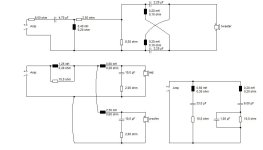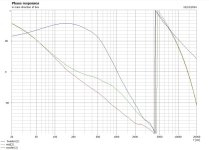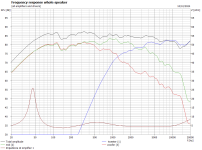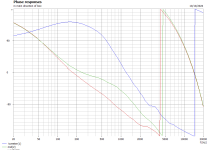A few months ago, I inquired about a capacitor/inductor filter I wasnt familiar with, on a post about Dynaudio speakers.
I now understand that this is an All Pass filter used for a time delay/ phase alignment of the tweeter.
On my current build, the tweeter is about 75deg phase shifted from the woofers between 1k-3k Hz. Moving the tweeter back 1cm solves this.
So does one of these All Pass filters with 1uF caps and 0.2mH inductors. It perfectly lines up the phase, and results in a deep null when the tweeter phase is flipped.
Any reason these filters are not more widely used on DIY builds here?
I now understand that this is an All Pass filter used for a time delay/ phase alignment of the tweeter.
On my current build, the tweeter is about 75deg phase shifted from the woofers between 1k-3k Hz. Moving the tweeter back 1cm solves this.
So does one of these All Pass filters with 1uF caps and 0.2mH inductors. It perfectly lines up the phase, and results in a deep null when the tweeter phase is flipped.
Any reason these filters are not more widely used on DIY builds here?
Attachments
Any reason these filters are not more widely used on DIY builds here?
There is a more effective way of dealing with the problem than wasting time and money on an all pass filter.
a more effective way of dealing with the problem than wasting time and money on an all pass filter
Just physical movement? My box is built, modifying it 1cm is neither physically nor aesthetically appealing. $20 in parts per speaker seems a good path (at least for me) to solve for that last bit of correction in my crossover.
I get it that it would have been better to correct for it earlier in the construction phase, tho.
I would rather use an all pass filter than a stepped baffle myself. A plate amp with digital crossovers is the modern solution that gives by far the best results often with the least cost. If you are building passive crossovers you have already given up on that so the expense and inconvenience of a passive crossover is part of the adventure.
I'm working on a passive crossover for a contest ( that doesn't allow active speakers, boo! ) this week and I'm going to look at using an all pass filter to match the phase between my 10" woofer and a 3" dome as the offset is large.
I'm working on a passive crossover for a contest ( that doesn't allow active speakers, boo! ) this week and I'm going to look at using an all pass filter to match the phase between my 10" woofer and a 3" dome as the offset is large.
All too true. My case is 50% learning and adventure, and 50% my need to use my favorite Tube amp for the power.If you are building passive crossovers you have already given up on that so the expense and inconvenience of a passive crossover is part of the adventure.
I always have a little global EQ available but that said, I've not been able to achieve better results using digital crossovers than I have with passive. I'm not saying one is better, I'm saying neither is a problem. It goes without saying that I had to invest whatever time and effort was required in each case to reach a given result.A plate amp with digital crossovers is the modern solution that gives by far the best results
I'll add to jayme's comments that in my experience, using a lattice network does what it does and the apparent complexity of the circuit doesn't stand in the way of it sounding as good as it should.
There is a more effective way of dealing with the problem than wasting time and money on an all pass filter
asymmetrical filtering is the solution
if i build a linkwitz-riley 4th order acoustic, its properties are well known.
what are the properties with asymmetrical filtering?
The properties are whatever you do with it and how you combine passive parts.
The point is to be able to delay a driver with minimum parts count and protect one
as an extra benefit.
The point is to be able to delay a driver with minimum parts count and protect one
as an extra benefit.
Last edited:
Flipping the phase of the tweeter in the Boxsim simulation shows a nice deep null from that phase alignment.
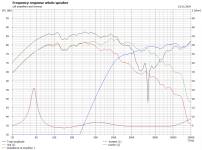
I have been playing with the crossover values, and the crossover design I posted above sounds the absolute best. I am using two SBAcoustics Satori MW16-P-8 midbass and the Satori TW29DN tweeter, in a 2.5 way. Sealed box, 50L single chamber.
Crossover is entirely external, connected to the speaker via a 8-pole Speakon connector. So super easy to tweak and modify.

I have been playing with the crossover values, and the crossover design I posted above sounds the absolute best. I am using two SBAcoustics Satori MW16-P-8 midbass and the Satori TW29DN tweeter, in a 2.5 way. Sealed box, 50L single chamber.
Crossover is entirely external, connected to the speaker via a 8-pole Speakon connector. So super easy to tweak and modify.
Since I have an external crossover, with just bare wire from each driver terminating to an 8 pole speakon connector in the speaker itself, I am tempted to buy one of those active filters and power it with a couple of the cheap class d amps I have for desktop and workout room systems. just to see how it sounds.I've not been able to achieve better results using digital crossovers than I have with passive
But when I flip on that EL34 tube amp and watch it glow, my desire for a perfect curve disappears. I just want to sit back and listen to the music from what I am able to configure on the analog side.
(total aside, but the Satori MW16-P has such a nice smooth response curve, minimal cone breakup, etc it has been an absolute joy to play with in experimentation for a relative newbie to the speaker-building side of this hobby, especially easy on crossover building. a bit expensive, but it falls into the "can't go wrong" camp)
Last edited:
Even if I dedicate the tube amp to the midrange driver, I would have to deal with gain matching, impedance differences, etc. seems easier to just go with a passive filter and a single amp.There's no reason you can't replace one of the digital amps with your EL34
you have created an undefined filter, how do you evaluate and measure its properties?The properties are whatever you do with it
here is a quote from member john k...
"when designing a speaker a crossover type is chosen, be it 1st order Butterworth or 8th order LR. Filters are then designed such that the acoustic response of each source matches the theoretical response of the chosen crossover filter as closely as possible. Then the drivers are positioned or delay added such that the inter driver phase difference in the crossover region matches that of the chosen crossover"
Parts count and alternatives. The all-pass filter is one of multiple ways of getting correct integration between two drivers. A stepped baffle, and changing the filter order of one of the two filters (high or low pass) also work very well.
I think of the all-pass and the stepped baffle as implementations only to be done when you are unwilling to compromise on the filter order. One good reason to not compromise filter order is to maintain excellent off-axis response.
I think of the all-pass and the stepped baffle as implementations only to be done when you are unwilling to compromise on the filter order. One good reason to not compromise filter order is to maintain excellent off-axis response.
Even on a recent build with an offset of 65mm, I didn't have to use a ladder delay. However, it was a combo of damped 12dB on the woofer and damped 3rd order on the tweeter, coupled with notches to either side of the xover point. It still yielded an LR4 in phase type response with a deep null.
- Home
- Loudspeakers
- Multi-Way
- All Pass Filter for tweeter time/phase alignment

